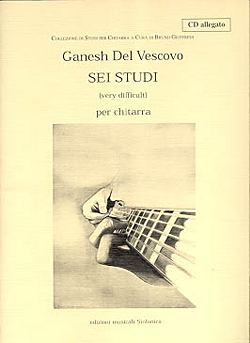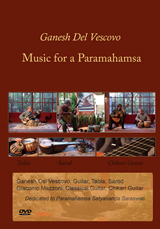"SEICORDE" ( April – June 2001 )
THE SHEET MUSIC OF THE MONTH
"DISCOVERING INDIA"

Ganesh Del Vescovo
Six Studies (Sei Studi) for the guitar
ed. Sinfonica 2000
40 pages + CD
Ganesh Del Vescovo, who had been a pupil of Alvaro Company, and attended Master Classes of Oscar Ghiglia, Eliot Fisk, Pepe Romero and Edoardo Fernandez, unites great sensitivity with the constant pursuit of new sounds and effects on the guitar.
This pursuit does not only come from the author’ fantasy and the studies he has made, but also from the classical music of India.
The six studies published by Sinfonica (a publishing house that, at the moment, is very busy producing music for the guitar; and the merit for this goes to its musical editor, Bruno Giuffredi) are the summing up of the technique of this very interesting guitarist-composer.
The first study (on a " nota ribattuta", repeated note) uses an Indian mode and the author uses this scale to construct a melisma accompanied by the repeated note (the E on the first string) which creates a very beautiful meditative mood. The second (on percussions) is a piece for the guitar transformed into a percussion instrument. It is very interesting. The third plays with micro-intervals, often using the bender and remains in an oriental musical atmosphere. The forth develops on glissandos and the last detail of this artifice reminds one of the sound and the timbre of the Indian instrument, the sitar. Number five is constructed all around a pizzicato effect with an instrumental slur, which is one of the inventions of the author (the right hand produces the first pizzicato and the left hand continues with the other notes): it is very difficult. The last study is dedicated to harmonics, with the pursuit of the projection of the sound. In this piece the guitar is tuned with the third string in F#.
This publication is accompanied by a cd of the author performing his own pieces.
The work is remarkably difficult to perform, but it is worth while reading it and studying it in order to widen the technical knowledge of our instrument. Compliments to the author, who has managed to express both research and poetry in such an elevated fashion.
Download PDF file (right-click on the icon above and select "Save Target As...")

 Italian
Italian English
English

